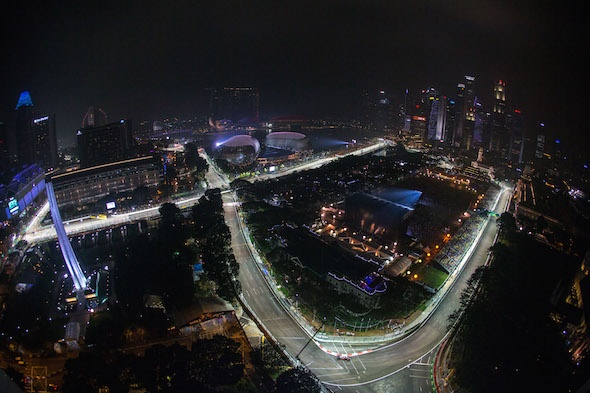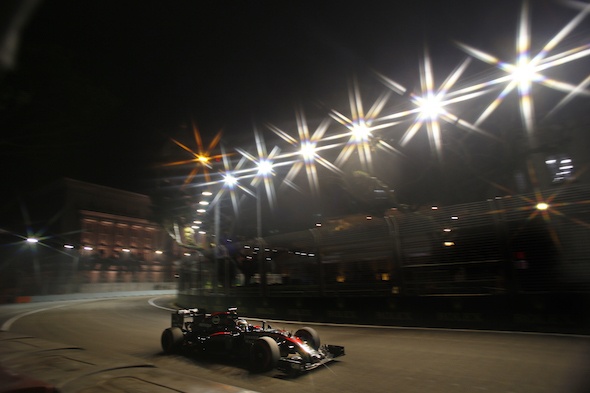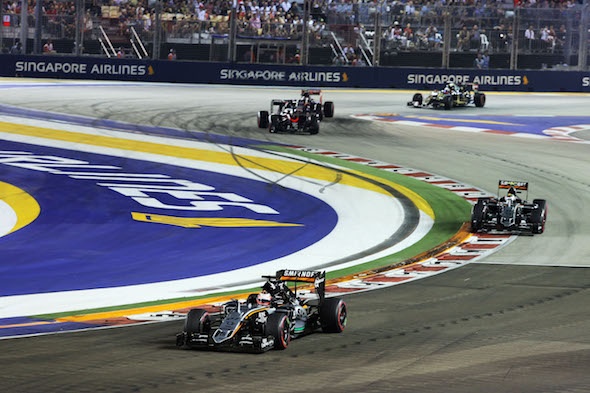
McLaren Honda
Formula 1 paddock moves from the shortest race of the year in terms of duration to the longest event on the calendar. It’s the Singapore Grand Prix, an event embraced by the drivers despite its tough challenges in terms of track and weather conditions.
As much as the Singapore Grand Prix is run at night for aesthetic purposes, nighttime is the coolest time for drivers and spectators alike. Nonetheless, temperatures inside the racecar can reach 60 degrees Celsius. With the barriers so close to the side of the track, no mistakes go unpunished during this two-hour marathon held in humid conditions.
Singapore has joined the Formula 1 calendar in 2008, with last year’s event serving as the venue’s eighth grand prix. By the time of its debut it was Formula One’s first night race and the first street circuit in Asia. Powerful lighting illuminates the track in such luster that drivers say it is even clearer than in daytime.
The Circuit
Marina Bay Street Circuit has seen only some minor changes since 2008 with the basic layout remaining unchanged in many aspects. It is a twisty circuit that features the highest number of corners of any circuit on the calendar but is the second-slowest lap after Monaco. It has some 90-degree turns combined with some technical sections with quick changes of direction.

McLaren Honda
The walls surrounding the track are unforgiving and in order for a driver to wring every ounce of speed from his racecar, he must dance with those walls while navigating the numerous bumps of the track’s surface. The bumpiness, the heavy braking zones, the lack of daylight and the humidity makes the race very testing for both drivers and cars. Drivers can lose up to 3 kilos over the course of the Singapore Grand Prix, thanks to the intense heat and humidity.
“The Marina Bay circuit is a challenge unlike any other that we face during the season - even when you compare it to the other street races on the calendar”, says Jenson Button.
“It’s twisty, extremely fast, the barriers are high and close, and the bumpy surface is unforgiving, which sometimes means losing grip is something you can’t get away with, without seeing flying debris all over the track and the possibility of a safety car. That’s part of what makes racing in Singapore so special, and its characteristics pose a tough test for even the strongest chassis and power unit. It’s gruelling for car and driver, but that’s what makes it all the more rewarding to drive.”
His team-mate Fernando Alonso is happy to return to a track where he previously scored two victories. “Singapore is a great race - it’s always an enjoyable weekend and definitely one of the halo races on the calendar each year. It’s a really long race - usually almost two hours - so a lot can happen. It’s tough on the cars too, especially with the current that runs underneath the asphalt near the Anderson Bridge towards Turn 13, which can play tricks on the electronics systems.
“Singapore is a really fun track, very bumpy and challenging, but it’s a quirky layout with a lot of stop-start sections and really fast straights, so you need a car that works well in high downforce set-up and has good traction out of the slower corners.”
The Race
Despite coming for the summer break with a 19-points advantage of Nico Rosberg, Lewis Hamilton is now just two points clear after his team-mate’s victories in Belgium and Italy. None of them finished on the podium at last year’s Singapore GP as Hamilton retired with power unit problems and Rosberg couldn’t manage better than fourth.

Sahara Force India
Every Formula 1 race at Marina Bay has come to within four minutes of the mandated two-hour time limit. Two races have been cut short of the scheduled 61-lap distance because of this limit: in 2012 (59 laps) and 2014 (60 laps). The longest race was last year’s event which eclipsed the two-hour time limit by 1 minute and 22 seconds.
Being run at night, track temperatures don’t evolve in the usual way seen at a daytime race. The ambient temperatures still remain high meaning that drivers have to manage degradation. On the other hand, the low-downforce characteristic of the track translates in the fact that the entire mechanical grip will come from tyres.
Tyres: soft, supersoft, ultrasoft
DRS: zone 1 - Raffles Boulevard, zone 2 - Main straight
Driver Steward: Mark Blundell
Weather: lows will range from 26-27 degrees Celsius to highs of 32-33 degrees Celsius
Facts and stats
Circuit length: 5.065 km
Turns: 23
Direction: clockwise
Race laps: 61
First Grand Prix: 2008
Lap record: 1:50.041 (Daniel Ricciardo, 2015)
Most wins (driver): Sebastian Vettel (4)
Most wins (constructor): Ferrari (3), Red Bull (3)
2015 Qualifying: Sebastian Vettel (Ferrari)
2015 Race: 1. Sebastian Vettel (Ferrari), 2. Daniel Ricciardo (Red Bull), 3. Kimi Raikkonen (Ferrari)
Moments in time
Felipe Massa left his pit box whilst the fuel hose was still attached after being given an erroneous signal.
Timetable (GMT +8):
Friday 16 September
Practice One: 18:00 – 19:30
Practice Two: 21:30 – 23:00
Saturday 17 September
Practice Three: 18:00 – 19:00
Qualifying: 21:00 (60 minutes)
Sunday 18 September
Race: 20:00 (61 laps or two hours)





















